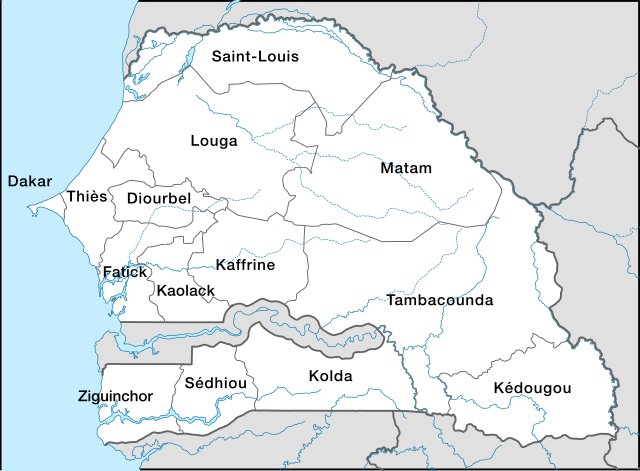Subdivisions of Senegal
From Wikipedia, the free encyclopedia
Senegal is subdivided into four levels of administrative divisions.
Regions
At the top level are the Regions of Senegal and their elected administrative body. The 14 regions (régions, singular - région), are administered by a Conseil Régionaux, which is elected by population weight at the Arrondissement level.
| Region | Capital | Area (km2) |
Population (2013 census) [1] |
|---|---|---|---|
| Dakar | Dakar | 547 | 3,137,196 |
| Ziguinchor | Ziguinchor | 7,352 | 549,151 |
| Diourbel | Diourbel | 4,824 | 1,497,455 |
| Saint-Louis | Saint-Louis | 19,241 | 908,942 |
| Tambacounda | Tambacounda | 42,364 | 681,310 |
| Kaolack | Kaolack | 5,357 | 960,875 |
| Thiès | Thiès | 6,670 | 1,788,864 |
| Louga | Louga | 24,889 | 874,193 |
| Fatick | Fatick | 6,849 | 835,352 |
| Kolda | Kolda | 13,771 | 714,392 |
| Matam | Matam | 29,445 | 562,539 |
| Kaffrine | Kaffrine | 11,262 | 566,992 |
| Kédougou | Kédougou | 16,800 | 152,357 |
| Sédhiou | Sédhiou | 7,341 | 452,944 |
Departments
Regions are subdivided into Departments, which are strictly administrative entities with no independent political power.
Arrondissements
Departments are made up of Arrondissements. These are also purely administrative structures, with prefects appointed by the central government.
Communes
City arrondissements (such as in Dakar and Pikine) are divided into Communes d'arrondissement. In the Dakar Region, since 1996, the four Arrondissements have been subdivided into such Communes d'arrondissement, with appointed Sub-Prefects, answerable to their Arrondissement Prefects. Outside the large cities, the built up areas are titled communes de ville and the rural arrondissements divided into communautés rurales which maintain the same powers: city councils and mayors, directly elected.
Senegal's subdivisions number 14 régions, 45 départements, 133 arrondissements, 46 communes d'arrondissement, 113 communes de ville and 370 communautés rurales.[2]
References
External links
Wikiwand - on
Seamless Wikipedia browsing. On steroids.
